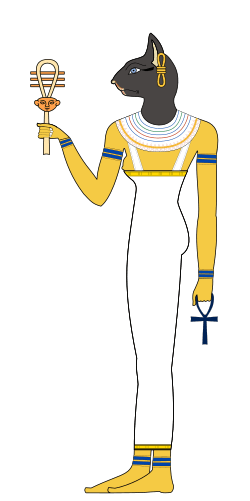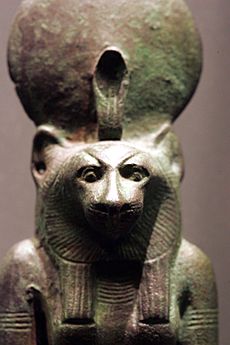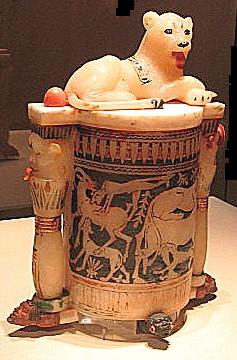Bast facts for kids
Quick facts for kids Bastet |
|
|---|---|

|
|
| Major cult center | Bubastis |
| Symbol | lioness, cat, ointment jar, sistrum, solar disk |
| Personal information | |
| Consort | Ptah |
| Offspring | Maahes |
| Parents | Ra and Isis |
| Siblings | Horus and Anhur (half-brothers) |
Bastet or Bast was an important goddess in the ancient Egyptian religion. People worshipped her as early as 2890 BCE, during the Second Dynasty. Her name can also be written as B'sst, Baast, Ubaste, and Baset. The ancient Greeks knew her as Ailuros, which means "cat."
Bastet was mainly worshipped in a city called Bubastis in Lower Egypt. She started as a fierce lioness goddess, similar to other powerful gods like Sekhmet. Over time, Bastet and Sekhmet were seen as two sides of the same goddess. Sekhmet was the strong warrior and protector. Bastet, who was shown more and more as a cat, represented a gentler side.
Contents
Understanding Bastet's Name

Today, most experts call her Bastet. The exact meaning of her name is still a bit of a mystery. One idea is that Bastet means "She of the ointment jar." This idea comes from how her name was written using the hieroglyph for an ointment jar. She was also linked to special protective ointments.
Another idea is that her name comes from a place called "Baset." So, "Bastet" would mean "she who comes from Baset." This shows her connection to a specific location.
Bastet's Role in Ancient Egypt
Bastet began as a powerful lioness goddess of the sun. She was worshipped this way for most of ancient Egyptian history. Later, she became known as the cat goddess we often see today. She was believed to be the daughter of the sun god Ra and the goddess Isis. She was also the wife of Ptah and the mother of Maahes.
As the protector of Lower Egypt, Bastet was seen as a defender of the king. This also meant she protected the sun god, Ra. Like other goddesses such as Hathor, Sekhmet, and Isis, Bastet was connected to the Eye of Ra. She was often shown fighting the evil snake Apep, who was an enemy of Ra.
Bastet also had a connection to the moon through another ancient goddess named Wadjet. Wadjet was called "eye of the moon." Bastet was also a goddess of pregnancy and childbirth. This might be because domestic cats are known for having many kittens.
People often made images of Bastet from a material called alabaster. Sometimes, she was shown holding a special musical instrument called a sistrum in one hand. In her other hand, she might hold an aegis. This was a type of collar or necklace decorated with a lioness head. Bastet was also seen as a protector against diseases and bad spirits.
History of Bastet Worship
Bastet first appeared around 3000 BCE. Back then, she was shown as a fierce lioness or a woman with a lioness head. About 2000 years later, during the Third Intermediate Period of Egypt (around 1070–712 BC), Bastet started to be shown as a domestic cat or a woman with a cat's head.
Later Egyptian writers added an extra "t" to her name, making it "Bastet." This was likely to make sure the "t" sound at the end was pronounced.
Cats in Ancient Egypt
Cats in ancient Egypt were highly respected. This was partly because they were great at catching pests like mice, rats, and snakes. These pests could threaten important food supplies. Royal cats sometimes wore golden jewelry and even ate from their owners' plates.
Around 945–715 BC, during the Twenty-second Dynasty of Egypt, the worship of Bastet changed. She became mostly a major cat goddess instead of a lioness deity. Because mother cats are gentle and protective of their young, Bastet was also seen as a good mother. She was sometimes shown with many kittens.
When the Greeks ruled Egypt during the Ptolemaic dynasty, they sometimes linked Bastet to their own goddess, Artemis.
Bubastis: Her Special City

Bastet was especially important in the city of Bubastis. This city was in the Nile Delta, near what is now Zagazig. The Egyptian name for the town was pr-bꜣstt, which means "House of Bastet." The Greeks called it Boubastis.
The Temple of Bastet
Herodotus, an ancient Greek historian who visited Egypt around 400 BCE, described Bastet's temple in detail. He said the temple was on an island, surrounded by two channels from the Nile. The city around the temple was built up, but the temple itself stayed at its original level. This meant you could look down into it from anywhere in the city.
A stone wall with carvings went around the temple. Inside, there was a grove of tall trees and a large shrine with the goddess's image. A long, stone-paved road led to the temple entrance.
Many ancient Egyptian texts also suggest that water surrounded the temple on three sides. This created a special lake called an isheru. These lakes were common at temples for lioness goddesses. Myths say that a fiery lioness was once calmed by the lake's water. She then turned into a gentle cat and made the temple her home.
At the Bubastis temple, many cats were found mummified and buried. Over 300,000 mummified cats were discovered when Bastet's temple was excavated! This shows how important cats were. If a cat died, families would mourn deeply. Those who could afford it would have their cats embalmed or buried in special cat cemeteries. Large cat burial sites have been found not only in Bubastis but also in Beni Hasan and Saqqara.
Festivals for Bastet
Herodotus also wrote about the most important festival in Egypt, which was held in Bubastis for Bastet. Each year, about 700,000 people would visit the town for this festival. They arrived in many crowded ships. Women would sing, dance, and play music on their way to the festival.
During the festival, many sacrifices were made, and a lot of wine was drunk. More wine was consumed during this festival than at any other time of the year. Records from the New Kingdom show that King Amenhotep III was present at one of these festivals. He made great offerings to Bastet.


